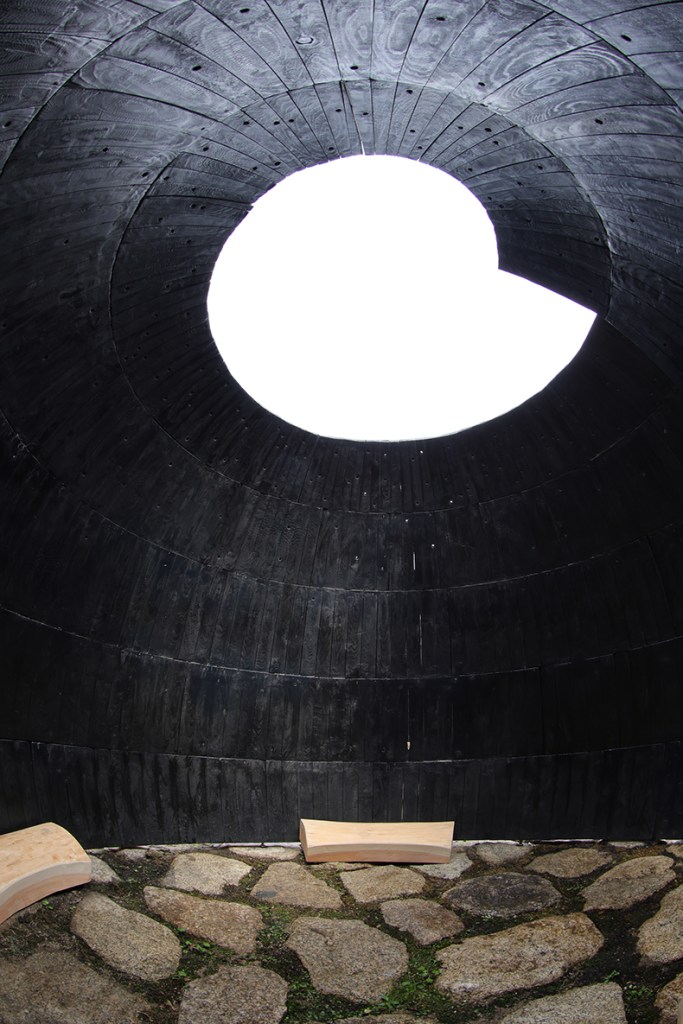Architect and collector, Kyoto
In 2021, Shunya Hashizume began renovating a century-old house in Taiza, a small fishing community facing the Sea of Japan, about two hours north of Kyoto. Nobody had lived in the house in more than two decades. Its yakisugi (charred cedar) facade was weathered; dust and grime coated its tatami mats, paper shoji window screens and walls. In Taiza, where the population of 1,600 was disproportionately elderly and declining, abandoned buildings were a common sight.
For Hashizume, then 26 years old and an architect fresh out of graduate school, this was no ordinary doer-upper. The plan was for the old house – now called Taiza Studio – to be used as a remote base where artisans, artists and chefs could get away to create, display their work and share their techniques. The building would be the first of several art, food and architecture projects that Hashizume hoped to develop into a miniature cultural centre within Taiza.
Taiza Studio by Tomorrow, with its yakisugi (charred cedar) facade, in Taiza, Japan. Photo: Noboru Morikawa; courtesy Tomorrow

The concept was the idea of Kayo Tokuda, founder of Tomorrow, the Kyoto-based not-for-profit where Hashizume works. Tokuda and Hashizume first visited Taiza, on the Tango Peninsula, in 2020, at the peak of the Covid-19 pandemic, while exploring towns and cities in the region. They fell hard for Taiza’s natural beauty, abundant food and craft traditions. The coastal basalt cliffs, ancient burial tombs, rich fisheries haul and centuries-old tradition of kimono silk-weaving and metalsmithing made the village the perfect place to implement their vision. ‘In the fifth and sixth centuries, this region was a centre for cutting-edge knowledge and new techniques from the Asian continent. We want to recreate that dynamism by bringing artists and artisans from around the world to be inspired and to experiment,’ says Hashizume, who is leading the venture, which is called Ashita no Hatake (Tomorrow Field).
For Taiza Studio, Hashizume asked a team of artisans to apply their skills on a bigger scale by constructing parts for the building. To repair the fusuma sliding doors separating tatami rooms, he called on the kyo-karakami paper artisan Ko Kado to develop washi made with local dirt, and ceramicist Akio Niisato to make door grips in a small outdoor kiln that they built nearby. For the kitchen, the master glassmaker Satoshi Sato produced hand-blown rondels to fix the broken corrugated glass on a wooden door. Third-generation ki-oke (wooden tub) maker Shuji Nakagawa used uneven pieces from a split log to construct the building’s eaves and assembled 100 two-metre-long cypress planks into a large, barrel-shaped space that could be used as the upstairs sleeping quarters. Each of the craftspeople has made dishes, cups, utensils and trays for everyday use. In the coming months, Hashizume and artisans from the 149-year-old Kyoto tea caddy workshop Kaikado will add new rain gutters to the roof. ‘You’re surrounded by the work of artists and artisans, like in a museum, except that here their work is for everyday use, not labelled for display,’ Hashizume says. ‘It’s been three years but Taiza Studio is still a work in progress. We’re also renovating two other buildings that will become an art gallery and a visitors’ residence.’
Interior of the renovated Taiza Studio. Photo: Noboru Morikawa; courtesy Tomorrow

Many of Hashizume’s nonprofit projects in Taiza and commercial work in Kyoto and nearby prefectures are like this: site-specific, rooted in handmade craft and made with natural materials that can be either recycled or taken apart and reassembled somewhere else. For a wagashi sweet shop, he designed a counter made with 13 tonnes of rammed earth, a method akin to that used for the construction of the Great Wall of China.
Last year, Hashizume invited the American artist Teresita Fernández and her 19-year-old daughter, Cypress Fernández-Downs, to Taiza for a collaboration with Nakagawa on the installation Field of Stars, a barnacle-like structure made of 600 charred cedar planks sitting in a shallow trough of stones. ‘I try to blur the border between craft, architecture and art, rather than thinking about them as separate disciplines, and to express this in the form of beautiful things that are used on a daily basis,’ Hashizume says. ‘Lately, I’ve focused on updating traditional techniques and using “regenerative” materials from our natural surroundings. Hopefully, this will get more young people interested in trying to keep our traditions alive.’
The interior of Field of Stars (2023), a collaborative work by Teresita Fernández, Shuji Nakagawa, Shunya Hasizume, Kohei Wakamatsu and Cypress Fernández-Downs. Photo: Noboru Morikawa; courtesy Tomorrow




